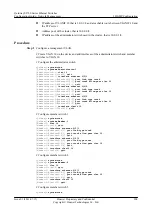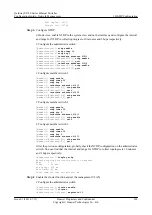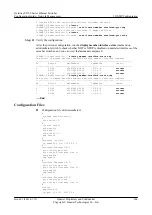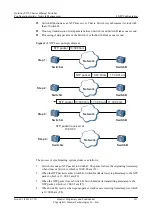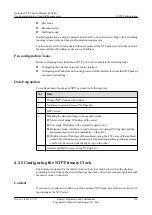
l
Peer mode
l
Broadcast mode
l
Multicast mode
In actual applications, a proper operation mode needs to be selected according to the networking
topology to meet various clock synchronization requirements.
For the unicast server/client mode and the peer mode, all the NTP packets sent locally can have
the same interface IP address as the source IP address.
Pre-configuration Tasks
Before configuring basic functions of NTP, you need to complete the following tasks:
l
Configuring the link layer protocol for the interface
l
Configuring an IP address and a routing protocol for the interface to ensure that NTP packets
can reach destinations
Data Preparation
To configure basic functions of NTP, you need the following data.
No.
Data
1
Primary NTP clock and its stratum
2
Interfaces to send and receive NTP packets
3
NTP version
4
Preparing the data according to the operation mode
l
Server/client mode: IP address of the server
l
Peer mode: IP address of the symmetric passive end
l
Broadcast mode: interfaces to send and receive broadcast NTP packets and the
maximum sessions set up dynamically on the client
l
Multicast mode: IP address of the multicast group, the TTL value of the multicast
packets, the interfaces to send and receive the multicast packets, and the maximum
number of the session dynamically set up on the client
5
Interface disabled from receiving NTP packets
4.3.2 Configuring the NTP Primary Clock
The stratum configured for the master clock on the server must be lower than the stratum
configured for the clock on the client. Otherwise, the clock on the client cannot synchronize with
the master clock on the server.
Context
If you want to configure a switch to provide a primary NTP clock, do as follows on the switch
functioning as the NTP server.
Quidway S2700 Series Ethernet Switches
Configuration Guide - Network Management
4 NTP Configuration
Issue 01 (2011-07-15)
Huawei Proprietary and Confidential
Copyright © Huawei Technologies Co., Ltd.
214

